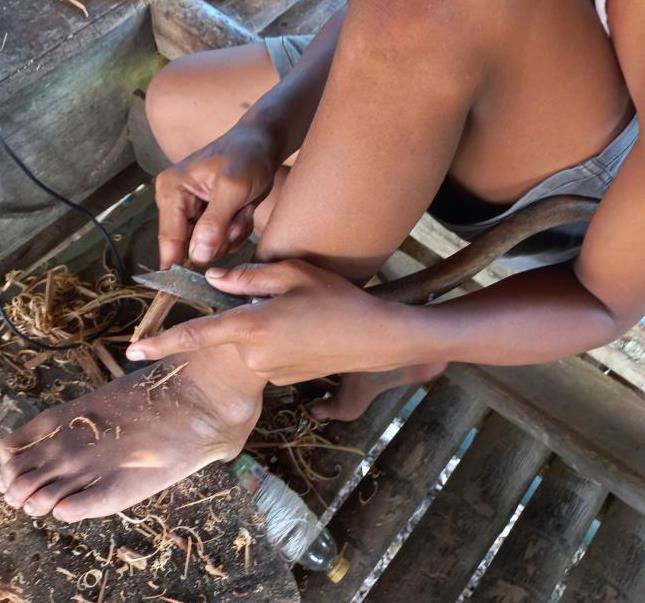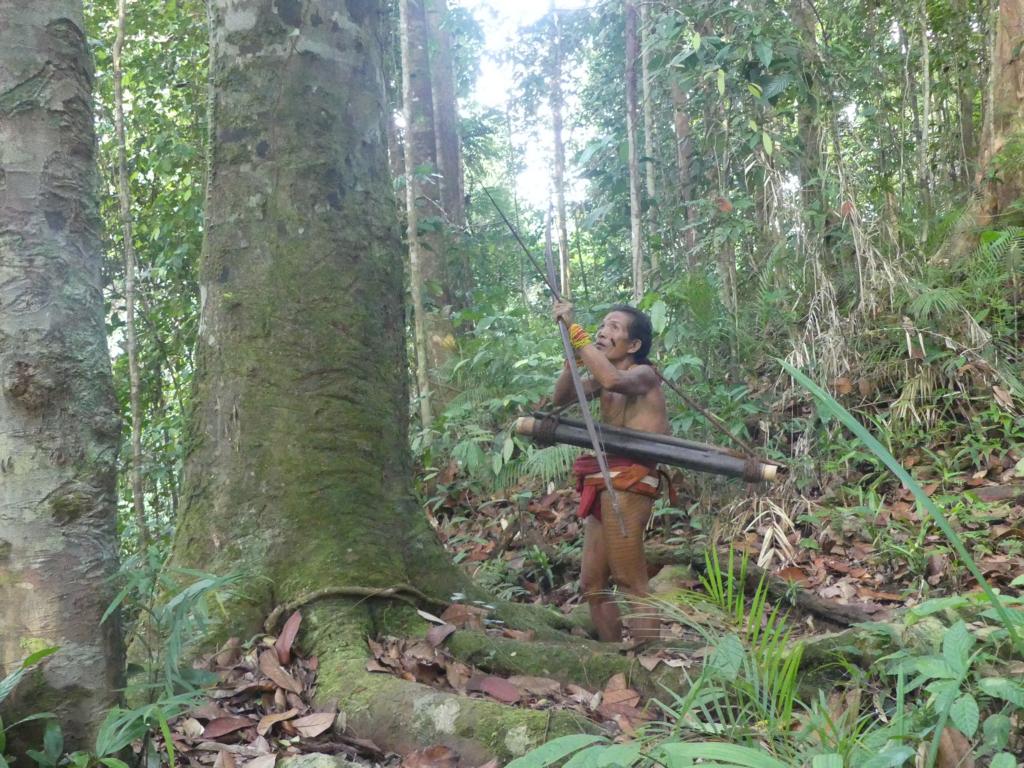Bows and arrows are the primary hunting weapons used by the Mentawai people. Their bows were already described here. This article will explain the different types of arrows used for these bows and give an insight into the quivers used. Another article described arrow poison and its manufacture.
Arrow shapes and designs
Three types of arrows are used: one designed primarily for monkey hunting, another for wild pig hunting, and one for bird hunting.
Arrows for monkey hunting

This is the most common arrow type. It is used for hunting monkeys and all other small game that can be penetrated with a wooden tip. These could include, for example, Flying foxes or Fruit bats, various species of Squirrels, Civet cats, and large birds like Hornbills.



The arrows consist of a shaft (‘Oshi’) and a pointed tip, which is stuck into the shaft and secured by windings of tree bark and glue (‘Onam’ – Myristica sp. tree). The arrow shaft length is about 55 cm / 21 1/2’’. It is made from shoots of a common bamboo species on Siberut, locally called ‘Maggeak,’ which belongs to the Poaceae taxonomic family.
The total length of the wooden tip is around 32 cm / 12 1/2’’, of which 7 cm / 2 3/4’’ are stuck in the arrow shaft. Therefore, an assembled arrow is around 80-90cm / 31 1/2-35’’ long. The wooden arrow tip is made from either ‘Poula’ sugar palm wood (Arenga pinnata) or the ‘Ari Ribuk’ palm (Oncosperma tigillarium), commonly called Nibong Palm in English.



Carving arrow tips
Both types of palm wood are difficult to carve, as they contain strings of fibers in their sapwood, which are extremely tough. Mentawai people, therefore, use a specially shaped knife, which they fixate between the upper arm and lower leg. In this position, they can scrap wood chips in the direction away from the body.



The arrow tip is pointed needle-like, and in its upper portion, a screwed notch will be carved for increased adhesion of poison. Behind the poisoned portion of the arrow tip, a notch will be carved as a predetermined breaking point.
The total weight of an assembled monkey arrow is about 20g / 0.7oz. The arrow speed is around 35 m/s / 115 ft/s, which results in a ballistically strongly curved trajectory. Therefore, not only is a strong pulling force necessary, but it also requires lots of experience in gap shooting.
Monkey arrows for squirrel hunting
When hitting a monkey (or humans in former times, when Mentawais were still head hunters before WW1), the first reflex will be to pull it out of the wound. In most cases, the tip will break at the notch, and the poisoned tip will remain within the victim’s body.

Mentawai hunters will take about 15 poisoned monkey arrows and five pig arrows in their quiver. Whenever they want to shoot squirrels, they pack a handful of a variation of monkey arrows, which are not poisoned and have not got a notch. After hitting a squirrel, the tip will not break off, but the stuck arrow will exhaust the squirrel until it falls from the tree.

I have not mentioned the nock area of all types of Mentawai arrows until now. Its design is very simple. Two V-like 45-degree cuts connected to the hollow stem form the notch. See the picture above.
Arrows for wild pig hunting

A small metal broadhead on a wooden arrow tip will be fitted to the arrow shaft for hunting wild pigs or other big game, such as Rusa deer, Muntjac deer, Sun bear, or other bigger game.


The blade is usually leaf-shaped but can also be triangular and is bound onto the wooden tip. Behind the binding, a screw will be carved for better adhesion of the poison. The notch, where the tip should break, is carved deeper than monkey arrows, and the total length of the tip and arrow is the same.

The main function of the broadhead and the notched tip is not to cut open large blood vessels but to penetrate the tough skin of target animals and deliver lots of poison into the bloodstream. Therefore, broadheads and connecting arrow tips contain considerably more poison than monkey arrows.
Arrows for bird hunting

Arrows for hunting birds and other small game have got a blunt nose. These knobbed arrowheads should not penetrate the animals but just stun or kill them with the shock on impact. Penetration of many bird species is not desired, as their feather will be used for ceremonial purposes and should not be spoiled by blood. These blunt arrowheads have the same weight as pointed arrows and follow the same ballistic trajectory.


These blunt heads are also used for shooting practice, as they will not get stuck in trees. We should have used such a blunt arrow tip for bow shooting practices from the Uma.
Quivers used by Mentawai people

All arrows for a hunt are stored in a quiver called Salukat in the Mentawai language. See here. This Salukat is a bamboo tube covered with a sheet of a sago palm leaf for protection against rain. This leaf is the brown section of the quiver in the picture below. Both open ends are closed by a section of short bamboo pipes, which can be seen as two light-colored sections. A coconut husk rope serves to carry the quiver.



As Mentawais normally shoots more than one arrow at an animal, about twenty arrows must be stored in the quiver.


It is only strung shortly before shooting to maintain the bow’s elasticity. The string is stored in another pipe on top of the quiver, holding a spare string.
Lessons learned about arrows and quivers of the Mentawai people
- Arrows are primarily used for monkey hunting. They consist of two parts and penetrate the target animals needle-like.
- Both monkey and pig arrows act by poisoning the target animals.
- Bird arrows have a blunt head for stunning the target animals and for training purposes.
- The quivers are bulky and carried on a shoulder strap.
.





2 comments
Josse
Thanks so much for all this detailed information.
A couple of years ago I found a bow and quiver with arrows of the Mentawai tribe in a local thrift shop. The only thing missing are the two strings you describe.
The top-end of my quiver is decorated with dots of monkey- or squirrel hair.
For the rest it’s all exactly as you describe.
The bow and arrow hang in my livingroom. Thanks to your extensive research they have gained a big amount of cultural vallue.
Thanks.
Josse
Kurt Hoelzl
Dear Josse,
Highly appreciate your feedback! It’s a good incentive to continue writing quality articles.
Kindest,
Kurt